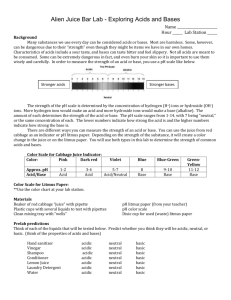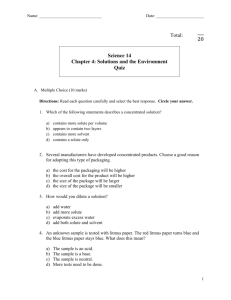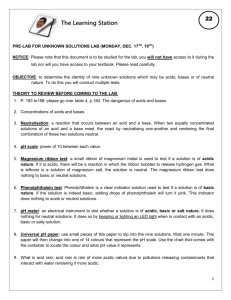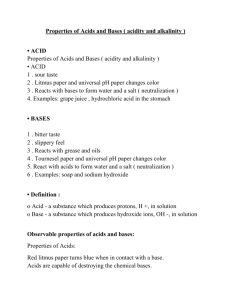Lesson - Vanderbilt University
advertisement
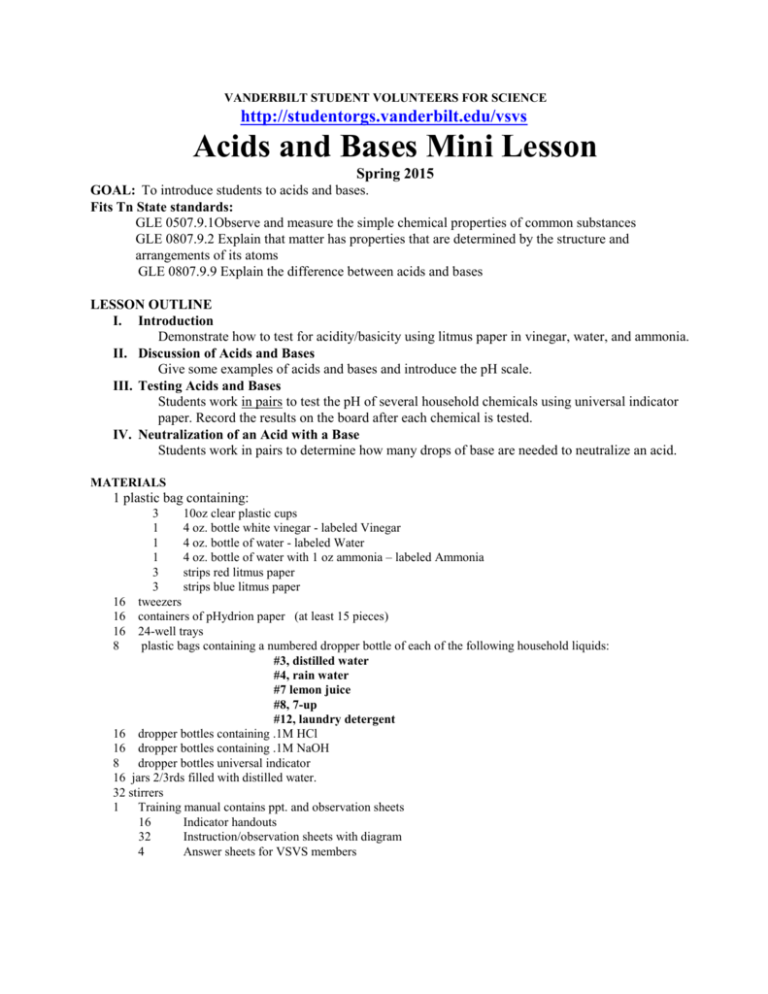
VANDERBILT STUDENT VOLUNTEERS FOR SCIENCE http://studentorgs.vanderbilt.edu/vsvs Acids and Bases Mini Lesson Spring 2015 GOAL: To introduce students to acids and bases. Fits Tn State standards: GLE 0507.9.1Observe and measure the simple chemical properties of common substances GLE 0807.9.2 Explain that matter has properties that are determined by the structure and arrangements of its atoms GLE 0807.9.9 Explain the difference between acids and bases LESSON OUTLINE I. Introduction Demonstrate how to test for acidity/basicity using litmus paper in vinegar, water, and ammonia. II. Discussion of Acids and Bases Give some examples of acids and bases and introduce the pH scale. III. Testing Acids and Bases Students work in pairs to test the pH of several household chemicals using universal indicator paper. Record the results on the board after each chemical is tested. IV. Neutralization of an Acid with a Base Students work in pairs to determine how many drops of base are needed to neutralize an acid. MATERIALS 1 plastic bag containing: 3 10oz clear plastic cups 1 4 oz. bottle white vinegar - labeled Vinegar 1 4 oz. bottle of water - labeled Water 1 4 oz. bottle of water with 1 oz ammonia – labeled Ammonia 3 strips red litmus paper 3 strips blue litmus paper 16 tweezers 16 containers of pHydrion paper (at least 15 pieces) 16 24-well trays 8 plastic bags containing a numbered dropper bottle of each of the following household liquids: #3, distilled water #4, rain water #7 lemon juice #8, 7-up #12, laundry detergent 16 dropper bottles containing .1M HCl 16 dropper bottles containing .1M NaOH 8 dropper bottles universal indicator 16 jars 2/3rds filled with distilled water. 32 stirrers 1 Training manual contains ppt. and observation sheets 16 Indicator handouts 32 Instruction/observation sheets with diagram 4 Answer sheets for VSVS members 1. In the car ride, read through this quiz together as a team. Make sure each team member has read the lesson and has a fundamental understanding of the material. Lesson Quiz 1) What is litmus paper used for? 2) What will an acid do to the blue litmus paper/the red litmus paper? 3) What will a base do to the blue litmus paper/the red litmus paper? 4) What will a neutral solution do to the blue litmus paper/the red litmus paper? What is an indicator used for and where does it change colors? How does the universal pH indicator work? 5) An acidic solution is higher pH or lower pH? A basic solution? 6) How can we treat stomach indigestion? How does it work? 7) Are the foods generally going to be more acidic or basic? 8) Are the cleaners generally going to be more acidic or basic? 2. Use these fun facts during the lesson: Naturally occurring acids: One naturally occurring acid is ascorbic acid, found in citrus fruits, which is more commonly known as vitamin C. Vitamin C is a crucial part of the human diet because without it we can get a disease called scurvy. Lactic acid in yogurt aids in the fermentation process. Also, lactate is produced during exercise and its buildup can cause for muscle soreness. Carbonic acid present in many soft drinks (sodas):. The bubbles and fizz that you see and hear is carbonic acid turning into carbon dioxide gas and escaping the liquid. The acid in soda can erode away the enamel in your teeth and leave them vulnerable to cavities. Old jewelry with an unattractive film on it can be dipped briefly in acid to clean it and return its metallic sheen. The acid eats away at the film on the outside to expose the clean, shiny layer underneath it. In fact, if you leave a dirty penny in soda or vinegar for a while, you might be able to clean off some of the film on the outside of it. Fluoroantimonic acid (H2FSbF6) is the strongest acid. It is a superacid, which means it is more acidic than 100% sulfuric acid. Proteins are made of acids called amino acids. Naturally occurring bases: Seawater is slightly basic because of dissolved minerals. Calcium carbonate and other carbonate minerals in limestone rock are basic. Bases can dissolve fats and oils so they are good on grease, which is why they are used in soap. However, bases can also remove the fats and oils in and on your skin. This is why your hands dry out after you’ve done the dishes for a long time. An amphiprotic substance is one that can act as both an acid and a base. Write the following vocabulary words on the board: acid, base, neutral, litmus paper, indicator, universal indicator Your Notes: ______________________________________________________________________________ ______________________________________________________________________________ ______________________________________________________________________________ ______________________________________________________________________________ Unpacking the Kit: VSVSers do this while 1 person is giving the Introduction. Note that students are put into pairs and should have their pencils ready. For Part I Introductory Demonstration: 3 10 oz. clear plastic glasses 1 4 oz. bottle of vinegar, 1 4 oz. bottle of water , 1 4 oz. bottle of dilute ammonia 3 strips red litmus paper, 3 strips blue litmus paper 16 Indicator handouts 32 Instruction/observation sheets For Part III: Testing Acids and Bases 16 tweezers 16 containers of pHydrion paper 16 24-well trays 8 plastic bags containing a numbered dropper bottle of each of the following household liquids: #3, distilled water, #4, rain water, #7 lemon juice, #8, 7-up, #12, laundry detergent For Part IV: Neutralization of an Acid with a Base 16 dropper bottles containing .1M HCl 16 dropper bottles containing .1M NaOH 8 dropper bottles universal indicator 16 jars half filled with distilled water. distilled water dropper bottle and well plates from Part II I. INTRODUCTORY DEMONSTRATION - DEFINING ACIDS AND BASES You will need: 3 1 1 1 3 3 10 oz. clear plastic glasses 4 oz. bottle of vinegar 4 oz. bottle of water 4 oz. bottle of dilute ammonia strips red litmus paper strips blue litmus paper • Have 2 VSVS volunteers hold the 3 clear plastic glasses up so students can see them. • Tell the students that you have three liquids. • Pour the contents of the bottle labeled vinegar into the first glass. • Pour the contents of the bottle labeled water into the second glass. • Pour the contents of the bottle labeled ammonia into the third glass. • Have a student describe the three liquids they see. Note: Describe liquids based on visual cues only. Students may assume that all three glasses contain water. At this point that is an appropriate assumption based on visual cues alone. Since the liquids were in different containers, the students may think that the liquids are different. Ask students if they have ever heard of litmus paper. If so, what is it used for? Litmus paper is used to test whether something is acidic or basic. Your Notes: ______________________________________________________________________________ ______________________________________________________________________________ ______________________________________________________________________________ ______________________________________________________________________________ Test each glass of clear liquid by dipping first the red and then the blue litmus paper into the liquid and noting what changes, if any, occur. (Record the changes on the board for students to copy onto their Results sheet.) Note: The vinegar should turn the blue litmus paper red; the water should not change the color of either paper, and the ammonia should turn red litmus paper blue. Explain to students: In this experiment, the liquids turned the litmus paper different colors because one is an acid, one is a base, and one is a neutral (neither an acid nor a base). Litmus paper is an indicator which can identify whether a substance is an acid or a base. Ask students if they can name any other indicators. Students may be familiar with bromothymol blue, universal indicator, or phenol red. These are chemical indicators. Red cabbage juice extract is a natural indicator. Many other plant extracts also change color in basic or acidic solutions. Tell students that: Indicators are substances that change colors when mixed with an acid or base. Indicators are used by scientists to identify what the pH of a substance is. Tell students to look at the Indicator handout. Point out a few examples of how they can be useful in different ways. For example, litmus can tell us if something is either a base or an acid. Methyl orange indicator changes color at pH 3/4. It is red below pH 4 and yellow above pH 4. Universal indicator has a large number of color changes at different pH’s and can more precisely tell us what the pH of a solution is. II. DISCUSSION OF ACIDS AND BASES Ask: What do you know about acids? (Ask students to name some acids.) Responses may include references to battery acid, acid indigestion, stomach acid, acid rain, citric acid, and chemicals in a lab. Ask: What do you know about bases? (Ask students to name some bases. Most students know less about bases than acids. Responses may include lye, detergents. EXPLAIN ACIDS AND BASES USING SOME OF THE FOLLOWING INFORMATION: (Note: Feel free to add other appropriate information but keep this discussion brief.) ACIDS Natural acids in food give foods a sour, sharp flavor. Strong acids can burn your skin. Many acids are corrosive. They eat away metals and other substances. Some acids can be helpful. The acid in your stomach aids in digestion. Two acids (sulfuric acid and nitric acid) cause damage in acid rain. Your Notes: ______________________________________________________________________________ ______________________________________________________________________________ ______________________________________________________________________________ ______________________________________________________________________________ BASES Bases taste bitter and feel slippery. Some bases are used to settle upset stomachs. Detergents and many cleaning solutions are basic. Strong bases can burn the skin. Ask the students: Has anyone heard of the pH scale? For VSVS information only: In 1909, the Danish biochemist S.P.L. Sorenson devised a scale that would be useful in his work of testing the acidity of Danish beer. This scale became known as the pH scale from the French pouvoir hydrogene, which means hydrogen power. The pH scale was designed to measure the acidity or basicity of solutions. On the pH scale, lower numbers are more acidic solution and higher numbers are more basic. Most household chemicals have pH’s between pH 0 and 14, but more concentrated solutions of acids and bases exist that go beyond either end of this scale. Like the Richter scale used to measure the extent of ground movement in earthquakes, the pH scale is a logarithmic scale. This means that a substance at pH 6 is ten times more acidic than a substance of pH 7, a substance at pH 5 is one hundred times (10x10) more acidic than a substance of pH 7, a substance at pH4 is one thousand times (10x10x10) more acidic than a substance of pH 7, and so on. III. TESTING ACIDS AND BASES Ask: How can scientists tell which solutions are acidic or basic? Based on the first experiment, some students may be able to reason that scientists could use different shades of color of litmus to tell how acidic or basic a solution is. Ask: When red litmus paper is used as the indicator, what color do the basic solutions turn it? Blue Ask: When blue litmus paper is used as the indicator, what color do the acidic solutions turn it? Red Tell students that they will use universal indicator paper which changes many colors depending on the pH of the solution. TESTING THE ACIDITY/BASICITY OF HOUSEHOLD ITEM • Organize the class into 16 pairs. Groups will be made of two pairs. • Students will test several household items to determine if they are acidic, basic, or neutral • Distribute the following materials to each group (there are enough materials for 16 pairs – the dropper bottles will be shared between two pairs): 2 2 4 2 4 1 well trays containers pHydrion papers (at least 15 in each) Instruction/observation sheets with the well-plate diagram pair tweezers result sheets with chart bag containing household liquids (to be shared between two pairs) Your Notes: ______________________________________________________________________________ ______________________________________________________________________________ ______________________________________________________________________________ ______________________________________________________________________________ Management tip – do one household chemical at a time, put the results on the board, and then go to the next chemical. VSVS member: Put the Testing Household Items chart (below) on the board. Testing Household Items Item Result of Test acid base or neutral 3. distilled water acid base or neutral 4. rain water acid base or neutral #7, lemon juice acid base or neutral 8. 7-up acid base or neutral 12. laundry detergent acid base or neutral pH Number What is the pH number? Tell the students to: Arrange the bottles of household chemicals in numerical order. Students place their well-plate on the observation sheet on top of the diagram. Squirt a small amount of liquid from the first dropper bottle into the first well and test its acidity/basicity by dipping a piece of pHydrion paper into the liquid in the well. Hold the paper with tweezers. Place the pHydrion paper in the labeled rectangle. Compare the color of the pH paper directly after the test to the colors on the vial and record the corresponding pH number on the line. Circle the color change on the results sheet, circle whether the substance is an acid, base, or neutral, and fill in the pH number. Report findings to the VSVS student who is completing the chart on the board. VSVSers need to make sure that students are getting the correct answers. Repeat this with all the liquids. Ask students (have them fill in the answers on their results sheet): Are the foods that we have tested acidic or basic? Mostly acidic. Are the cleaners that we have tested acidic or basic? Basic Is there any difference in acidity of distilled water and rain water? Rain water usually tests slightly acidic because of dissolved carbon dioxide. Pollutants from burning fossil fuels such as sulfur oxides and nitrogen oxides can cause the rain water to be even more acidic (hence acid rain). Distilled water should be neutral. Your Notes: ______________________________________________________________________________ ______________________________________________________________________________ ______________________________________________________________________________ ______________________________________________________________________________ Testing Household Items - Answers Item Result of Test acid base or neutral pH Number What is the pH number? Neutral 7 4. rain water acid 5-6 7. lemon juice acid 3 8. 7-up acid 3-4 12. laundry detergent base 12 3. distilled water IV. NEUTRALIZATION OF AN ACID WITH A BASE Ask students if they know what happens when an antacid is taken for an upset stomach. The pH of your stomach varies, from 1-2 up to 4-5. When you eat, the stomach releases proteases and hydrochloric acid to aid in digestion. After a high-protein meal, your stomach pH may drop to as low as 1 or 2; however, buffers quickly raise the pH back to 3 or 4. After the meal has been digested, your stomach pH returns to a resting level of about 4 or 5. Stomach indigestion is often caused by too much acid in the stomach. An antacid will react with the acid in your stomach and help neutralize it. Pass out the 2 jars of distilled water, 1 dropper bottle of .1M HCl and .1M NaOH to each pair, and 1 universal indicator bottle to each group of 2 pairs. Pairs will share the universal indicator. Tell students to: 1. Put a squirt of the .1M HCl in first well on the bottom row (D1) as indicated on the observation sheet. Add a few drops of the universal indicator and note the color. 2. Repeat with a squirt of .1M NaOH in D2. 3. Repeat with a squirt of distilled water in D3. 4. Add a squirt of Universal Indicator to the 2 jars of distilled water. Note the color. 5. Add 20 drops (counting carefully) of .1M HCl into one of the jars. Note the color. What is the pH? 6. Add .1M NaOH one drop at a time, counting the drops added, and observing the color change in the universal indicator. Stop when the universal indicator color is that of neutral pH7. Record the # drops needed to neutralize the acid. 7. Add 20 drops of .1M NaOH to the other jar and note the color. What is the pH? 8. Add .1M HCl one drop at a time, counting the drops added, and observing the color change in the universal indicator. Stop when the universal indicator color is that of neutral pH7. Record the # drops needed to neutralize the base. Optional Information How is litmus paper made? Litmus paper is simply paper that has been infused with lichens. Ask students if they have seen lichens growing. They may not be aware that lichens are very common and can be found growing on rocks, Your Notes: ______________________________________________________________________________ ______________________________________________________________________________ ______________________________________________________________________________ ______________________________________________________________________________ trees, walls and in soil just about anywhere in the world. They have a natural ability to change color depending on the conditions they are growing in. Several varieties of lichens are used to make litmus paper. How is Universal indicator made? It is a combination of several chemical indicators so that there is a continuous change of colors over the pH range of 0-14. Universal Indicator can also be impregnated into paper to be used as the pHydrion paper. Red cabbage extract has a similar range of colors due to the natural compound anthocyanin. You can make red cabbage indicator paper at home using red cabbage extract (by boiling red cabbage in water) and soaking coffee filter paper in it. Reference: Fun with Chemistry, Vol. 2, 2nd edition; Sarquis, M; Sarquis, J. Eds., Publ. 91-005, Institute for Chemical Education, University of Wisconsin: Madison, 1991; pp. 53-62. Lesson written by Dr. Melvin Joesten, Chemistry Department, Vanderbilt University Pat Tellinghuisen, Coordinator of VSVS, Vanderbilt University Courtney Luckabaugh, VSVS Lab Manager, Vanderbilt University Your Notes: ______________________________________________________________________________ ______________________________________________________________________________ ______________________________________________________________________________ ______________________________________________________________________________ Acids and Bases Instruction Sheet Place well plates on the picture below. Make sure that you can see the numbers in the wells. 2. 3 4 7 8 .1M HCl .1M NaOH Distilled Water 12 After you have tested the household chemical with the pH paper, place the pieces of paper in the box below. Determine if it is an acid, base or neutral liquid, and circle the correct answer. Record the actual pH number for each chemical on the line provided. 3. Distilled water 4. Rain water acid base neutral acid base neutral pH ______ pH ______ 7. Lemon Juice acid base neutral pH ______ 8. 7-Up 12. Laundry detergent acid base neutral pH ______ acid base neutral pH ______ Observations from Introductory Demonstration I (copy from the board) Red litmus turns… Blue litmus turns… Is it an acid, base or neutral? Vinegar Water Ammonia Are the foods that we have tested acidic or basic? ___________________ Are the cleaners that we have tested acidic or basic? ___________________ Is there any difference in acidity of distilled water and rain water? ___________________ _______________________________________________________________________________ How many drops of .1M NaOH did it take to neutralize the 20 drops of .1M HCl? ____________ How many drops of .1M HCl did it take to neutralize the 20 drops of .1M NaOH? ____________ Acids and Bases - Answer Key 1. 3. Place well plates on the picture below. Make sure that you can see the numbers in the wells. 3 4 7 .1M HCl .1M NaOH Distilled water 12 After you have tested the household chemical with pH paper, place the pieces of pH paper in the boxes below. Determine if it is an acid, base or neutral liquid, and circle the correct answer. Record the actual pH number for each chemical on the line provided. Record the pH number based on the first color change of the pH paper!!! As it sits, the color of the paper will change. 3. Distilled water 4. Rain water neutral pH 7 8 7. Lemon juice acid pH 5-6 8. 7-Up acid pH 3 acid pH 3-4 12. Laundry detergent base pH 11 Acids/Bases Answer Sheet Read the name of the item. As you do the experiment, circle the actual color change and circle if the substance is an acid, base or is neutral. Testing Household Items Item Result of Test pH Number acid base or neutral What is the pH number? 3. distilled water Neutral 7 4. rain water acid 5-6 7.Lemon Juice acid 8. 7-up acid 3-4 12. laundry detergent base 12 Are the foods that we have tested acidic or basic? Mostly Acidic Are the cleaners that we have tested acidic or basic? Mostly basic Is there any difference in acidity of distilled water and rain water? Rain water usually tests slightly acidic because of dissolved carbon dioxide. Pollutants from burning fossil fuels such as sulfur oxides and nitrogen oxides can cause the rain water to be even more acidic (hence acid rain). Distilled water should be neutral. How many drops of .1M NaOH did it take to neutralize the 20 drops of .1MHCl? It should take about 20 drops.


